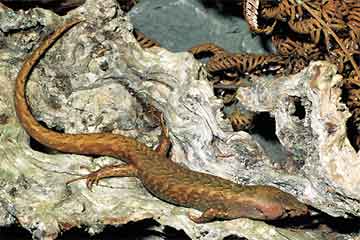|
|
|||
|
||||
|
Updated: September 12, 2001 |
|
|
|||||||||||||||||||||||||||||||||||||||||||||||||||||||||||||||||||||||||||||
 The chevron skink with distinctive markings along its back |
The chevron skink is the rarest lizard in the world. It is New Zealand's largest endemic lizard (Oligosoma homalonotum). This skink can grow to 30cm in length.
The name "Chevron" refers to the arrow pattern found along the length of its back and tail. It looks a bit like a woven flax kit. It also has a teardrop marking under its eye. Like all skinks it is snakelike in appearance, as it doesn't have a defined neck.
For nearly 60 years the chevron skink was not sighted. It was spotted on Great Barrier Island in the 1970's. It lives on the damper western side of the island.
Its habitat has been destroyed through compaction of the leaf litter (home to lizards) by browsing animals such as pigs, cattle and goats.
Cats are also a major threat especially as they are so mobile in their hunting range and can travel long distances to hunt their prey.